Reinventing the Big Game
We have all played in a big game more than once or twice in our BattleTech gaming lives. Chances are you have played in quite a few over the years. I’m talking about the big convention games with loads of people piloting more ‘Mechs and combat vehicles than you can shake a stick at on a vast battlefield with all the trimmings.
Inevitably the game’s turns begin to grind. Full turns are measured in hours not minutes. You spend more time waiting for your turn than actually executing your movement or attacks. At least you can drive to pick up some pizza without missing much.
The strategy and tactics necessary to win are lost in the confusion. Each individual player has little to do with the overall outcome. There are few opportunities to make good strategic advances when six other people on the team are planning their own opportunities. The game becomes less personnel, where the strategy and tactics of the individual mean less to the overall success of the mission.
There are obvious exceptions to the rule but in my experience a majority of large convention games regress to an impersonal ‘Mech smashing fest (not that there is anything wrong with that). If there are more than four players at the table, you can probably kiss goodbye any chance you had at making a meaningful impact on the course of the game. I wanted a change and set out to make a big game with lots of players who all had a chance to make a difference in the big picture. Here are my goals.
- Make it Personal – Each player should feel they made an impact on the game.
- Make it Fast – Nobody likes a game that does not come to a reasonable conclusion or turns that drag on and on.
Along Came Historicon 2010
I wanted to try something different and Historicon gave me my opportunity. I was on the hook to run one big game for up to 12 people. My plan was to make a massive battle with ‘Mechs, Combat Vehicles, Battle Armor, Aerospace Fighters, and Artillery (Oh My!).
This game would ultimately use Total Warfare, Tactical Operations, and Strategic Operations. How cool is that? We have all of these cool rules so why not use them?
How It Works
Break open your Total Warfare books and read along. These rules in conjunction with Tactical and Strategic Operations are the back bone of this big game experience.
The foundation of the big game came from using a low altitude map for the Aerospace dogfight. On this map, each hex represents one ground mapsheet on which the ‘Mechs and Vehicles are fighting. We used four standard battles each two maps large.
Using numbered BattleForce blip counters, I marked the relevant maps on the low altitude maps. When a fighter ended movement on one of those hexes I carefully notified the ground forces of their presence.
I say carefully since aerospace fighters move after ground troops. They should have the privilege to see where the ‘Mechs are and how they are facing before determining their final location. I allowed ground forces to move at the same time as the fighters to save time.
Synchronized Turns
To keep things running smoothly all of the turns need to be aligned. When the aerospace fighters swoop in for a strafing run, you had better let the ground troops know there is a fighter in their map so they can act accordingly in the weapons attack phase.
I chose to use a relatively simple solution to keep everyone in sync. Each battle had a half sheet of paper marked READY (green) on one side and NOT READY (red) on the other. At the beginning of each turn the players flipped the paper to NOT READY. With a quick glance I could see who was done and who was still resolving combat.
On a few occasions some players finished well ahead of the other battles. More experienced players will tend to do that. However, I also think the force selection had something to do with it. For future battles done in this style I will try harder to match the average weight and tech level in each battle to avoid major mismatches between battles.
The other half of that problem is when one battle lags behind the others. That happened twice where a relatively inexperienced player was playing. Given that no fighters were in their hex, I waited a few minutes and started the other turns. I simply asked them to head right into their next turn when ready. That will always be a judgment call based on the activity of the fighter battle but it worked out for us.
Using fighters in low altitude requires a good read through of the rules and demands the attention of your most experienced players. It is a very critical role to fill with many crucial decisions. When to make a strike run? Where to position your forces? How low do you go for fear of becoming a lawn dart?
Total Warfare is not the best tome for parsing all the various rules required to play Aerospace. That said, I had prepared a cheat sheet to help players who are new to the dog fighting and strafing world of air-to-ground combat.
Fighter Reference Sheet – PDF (45 KB)
The coup de grâce of the game was going to be a fully loaded Leapord Dropship for each side. Combat drop rules would be used to inject ‘Mechs into the various battles. Watching the pace of the ground battles I chose to keep the dropships in reserve. I didn’t see the kind of casualties I thought would require the use of a new lance per side and instead let the battles run their course.
Having thought about it, I wish I had let the players have at it. The downside would be the potential unbalancing of one battle or another. However, I believe the coolness factor of combat dropping ‘Mechs would have been worth it. Plus, any combat dropped ‘Mechs are sitting ducks for at least one turn at best. Ample opportunity to take cover from opposing ‘Mechs on the ground and point all weapons to the skies!
Artillery is an inspiring tool for some and ignored by others. Each team had access to off board artillery (1 turn flight time) in the form of one Sniper and one Long Tom. Requests for artillery were delivered to me on note cards and I assigned rounds to the battles in the event that there were more requests than available strikes.
Artillery made for some very interesting situations but did not turn the tide in any battle by itself. A beautiful example was the city fight. The first turn, both called artillery on the other when most units were walking along the roads out of LOS. The damage was brilliant. Each round struck multiple targets and delivered consequential damage. The turn after, the ‘Mechs moved the hell off the roads! It changed the dynamic of the game without breaking it.
‘Mechs are still kings of the battlefield. Artillery is a spice that was fun and managed to change the tempo for some but not all of the games. With a GM running the battle on the sidelines, the note card system worked well but could have used a standard format for requests.
The Report
In a stunning display of combined arms antics, the opening turn saw all four fighters from the Marik side diving into the nearest battle to strike at an enemy Warhammer. Unfortunately for the fighter group, without any other targets to worry about on turn 1, the entire Lyran lance opened up on the Transit and blasted it out of the sky with a(n) (un-)fortunate fuel tank hit. Already one fighter down, the Marik player continued to harass ground targets while being picked apart by enemy fighters in the air.
Meanwhile on the ground, the battle raged back and forth but saw a distinct advantage starting to build for the Lyrans.
It was late in the game when the Lyrans won complete air superiority but still the Lyran air commander decided to mostly concentrate on the last remaining Marik fighter.
In the end, the Lyrans had enough of an edge in the ground games to secure final victory for the overall battle. And with air superiority firmly in grasp there was no stopping the Lyrans.
I had lots of compliments on the game. Every player with a few obvious exceptions was 100% engaged in the game the entire time. There were a few turns where one battle finished way early and two occasions where the group was waiting on one battle to finish. Still, turns averaged a half hour a piece and we got through 8 complete turns in our allotted time with a clear winner at the end.
There was a base battle value (not accounting for pilot’s skill) of over 55,000 in play which included 32 ‘Mechs, 8 vehicles, 1 Battle Armor, and 8 aerospace fighters and we finished the game in less than 5 hours to a clear victor. Given the opportunity, I’d love to do it again and I bet it would be even better having learned from this first go.
Posted under Articles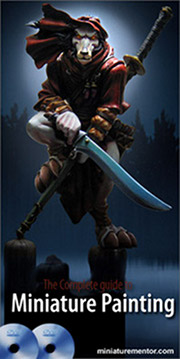





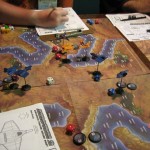
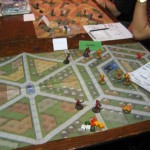
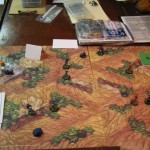
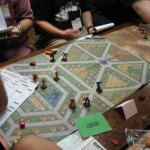
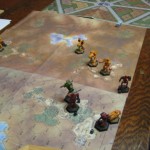
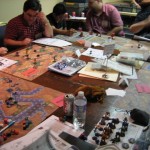
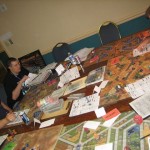
Good writeup. Maybe next year you’ll do it at a real convention.
Greetings,
Can you elaborate on the ground map layouts? I’m looking at the picture and I think I understand what you did, but want to make sure.
It looks like you physically separated the battle into sub battles, where each battlefield was not immediately next to another one. Am I seeing this right?
If not, I’m unclear how you sped up the ground battle, if it was all on one continuous battlefield.
If you did have things separated, did you have the concept of Off Map movement to move a unit from one battlefield to the next?
Thank you, very interested in more details.
Joel BC
Joel,
That is correct. The 4 ground battles were located in separate areas of the aerospace battle. The ground battles were much too far apart for a ‘Mech to travel from one ground battle to another since the closest ones were about 7 hexes away where each hex on the aerospace map was a mapsheet. You can see the pairs of BattleForce blip counters in the aerospace map picture above (the 4th pair in the background is partially obscured by a fighter) where each pair was one of the 4 ground battles that took place on 2 mapsheets each.
I really enjoyed the game even though I’m a total newb at flying aerospace. I have to thank my opponent for being patient with me and I apologize to everyone else for holding up the game while resolving attacks two of the turns :) It was pretty funny though that I was getting beat up, yet still strafing the enemy.
Impressive. It reminds me of the time I organised a big battle for a days gaming using Battleforce/Battletech crossover I had come up with back in the day. Players commanding forces on different maps, and the command team in a different room using CBs to talk to each other.
Historicon > DexCon any year…
I have been thinking about running something like this before. You are exactly right about the time problem. I’ve found that in large groups, much of the time is lost when teams are trying to decide who is going to move first. Initiative “cards” and a rule that units must be moved within about 15 secs or stay seems to move things along much faster.
I would like to make something like, a battletech battle, an aerospace battle and a battletroops battle. The battletech fight would feature an assault on fortified positions with an automated defense system. The battletroops battle would determine who controls the automated defense system.
Interesting- Would be interesting to put the battles close enough that people could choose to make a strategic choice to abandon one battle to reinforce another.
Thank you for the feedback.
Very cool idea. I might give that a try next time.
I wouldn’t want to make the maps too close though. I’d fear everyone would wander into one big battle which would miss the point of having separated games.
Thanks for taking the time to post Joel!
Brilliant! Great to see you were at Historicon, and I’m happy to hear that game synchronizing works so well. 5 hours is a major coup :)